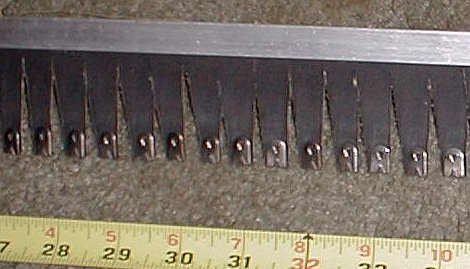
|

|

|

|

|

|
| Home | Manuals | Supplies | Search | Consult | Contact | Testing | Service |
|
Over the past century, various manufacturers have designed and built numerous types of attachments for the player piano. By far, the most popular attachment has been the "Mandolin Attachment". Due primarily to patent laws, these attachments have been given a variety of names like "Rinky-Tink", "Honky-Tonk", "Ukalando", "Banjo", and "Mandolin". However, they all operate in the same basic manner and have the same basic effect on the sound of the piano. Most clearly stated, activating the mandolin attachment changes the tone of the piano from normal to "tinny". This is accomplished by placing a piece of hard material between the felt hammers and the metal strings. So, instead of the felt hitting the strings, the hard material hits the strings. Basically, three types of hard material have been used. They are metal, plastic and wood. These pieces of hard material are mounted on a flexible piece of material which, in turn, are mounted on some type of a "rail". 
As you can see above, a piece of felt is placed between the hammers and the strings in the bass register. This is done to soften or 'mute' the bass register of the piano because it is typically louder than the tenor and treble registers. However, not all manufacturers used muting felt to soften the bass register. Some makers used heavy bellows cloth. Regardless of the material that is used, the intention of the manufacturer was to 'balance' the volume of the bass register so that it matched the other registers. To begin with, I glued a 3" strip of heavy bellows cloth to the rail with 3M Hi-Strength 90 Spray Adhesive. Regarding the basic construction of the "tickers", there are two basic considerations. One is "how tinny" the piano will sound, and the second is "how long it will last". Naturally, metal will last longer than plastic or wood. However, using metal produces a very tinny tone. So here again, selecting the 'best' material for the job is kind of a balancing act. The bottom line is that the aim is to use materials that render a 'balanced' tonal character throughout the entire range of the instrument. The basic design of the tickers has remained consistent for the last 100 years. The length of each ticker should be 1.5"-2.25". The width of each ticker should be slightly wider than the width of a hammer head, or about 3/8". Mandolin Rail Tabs are available at Player-Care. 
As can be determined by looking at the three pictures above, the rail is sized such that it fits between the two inner sides of the piano. However, numerous devices have been invented to bring the attachment into operation. The easiest 'on-off' device involves just one spring. The spring is attached to the rail such that it will hold the rail above the hammers when not in use. Then, disconnecting the spring allows the tickers to fall between the hammers and the strings. To limit how far the tickers will fall, a wood screw is screwed into both inner sides of the of the piano at the 'optimum' position. The optimum position is determined by the user. It is recommended that various depths be tested before the screws are put into place. Another common device used to turn the device 'on and off' is a 'gear shift lever/cable' like those used for changing gears on a bicycle. Mounting the gear shift lever under the keyboard, this allows the user to activate and de-activate the mandolin rail without opening the piano. Here again, a spring is used to hold the rail in the 'up' position when not in use. Activating the shift lever then 'pulls' the rail into position. As a word of caution, using a mandolin attachment for extended periods of time "WILL" deform the faces of the hammers. Typically, the faces of the hammers will become 'flat', increasing the hardness and/or tinniness of the tonal character of the piano. It is for that reason that it is recommended that the attachment be used sparingly. Below is a listing of some of the parts I've located that can be used to make the mandolin rail. I cannot guarantee the accuracy of the listings or links as they might change over time.
Aluminum Bar Stock (1/8" x 1/2" x 6'): McMaster-Carr, Part No. 8975K577
|

![]() ..To
The Top of this Page . . . . . . . . . . .
..To
The Top of this Page . . . . . . . . . . . ![]() ..To The HOME Page
..To The HOME Page
|
Since "Player-Care" is an internet business, I prefer that we correspond via E-Mail (click here to fill out the 'Request Form'). However, if I'm not in the middle of some other activity, you can reach me at 732-840-8787. But please understand that during the hours from 8AM-5PM EST (Mon-Sat), I'm generally quite busy. So, I probably won't answer the phone. If you get the answering machine, please leave a detailed message stating the reason for your call. Also, repeat your name and phone number clearly and distinctly. By necessity, I prioritize everything in my life. And, if you call and just leave your name and number, and ask me to call you back, it might be a day or two before I return your call. Why? Because I don't know why you want me to call and I might not be prepared to assist you in an effective and efficient manner. If you leave me an E-Mail address (which I prefer), spell it out phonetically. The more you do to help me, the more I can help you in return. Don't rush. You have four minutes to record your message. |
|
407 19th Ave, Brick, NJ, 08724 Phone Number 732-840-8787 (Voicemail Only, No Texts) |
